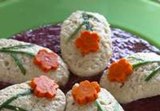 About 70 years ago, the carp immigrated to Israel from Eastern Europe, together with the Jewish pioneers. The fish came straight from its gray and chilly homeland to the blazing hot Beit She’an Valley, achieving a successful absorption in its new habitat and in Israeli stomachs. Around 6,800 tons of carp are consumed annually in Israel, some 1,000 tons at Pesach.
About 70 years ago, the carp immigrated to Israel from Eastern Europe, together with the Jewish pioneers. The fish came straight from its gray and chilly homeland to the blazing hot Beit She’an Valley, achieving a successful absorption in its new habitat and in Israeli stomachs. Around 6,800 tons of carp are consumed annually in Israel, some 1,000 tons at Pesach.
Amitai Geva, an Agriculture Ministry fish farming expert and a fish farmer himself, seeks to correct the battered image of the lowly carp. “Its image is unjustified,” Geva says with evident passion. “Thirty years ago its growing conditions weren’t the best, and it was very fatty. Today its nutrient is balanced, and its fat content is just 6.5 percent – less than salmon, mackerel or sardines.”
Geva says carp is used not only to make gefilte fish, but also as the base for the spicy, North African hraimeh, “and it’s very tasty grilled or fried.”
Carp was the most popular fish in Israel until just a few years ago, when it was knocked off its throne by tilapia.
But in the last decade commercial carp breeding has been hit hard by the carp virus, which kills about 90 percent of the fish in the early stage of life. This week about four million carp fingerlings in the fish ponds of the Beit She’an Valley are being immunized against the virus, a step that Agriculture Ministry officials said Wednesday was vital to insuring sufficient supplies of the adult fish ahead of Rosh Hashanah.
Carp virus arrived in Israel in a shipment of koi fish, ornamental varieties of carp. The virus does not affect other species of fish or human beings.
“Since carp develop resistance to the virus only after the age of three months, there was a need to protect them in their earliest stages of growth,” Geva explains. The Agriculture Ministry adds that this need spurred development of a “natural vaccine and special summer care for fingerlings, similar to infant immunizations. The treatment is administered annually in July and saves the lives of more than 70 percent of the treated fingerlings.”
Fishery experts at the ministry studied how to achieve the best results in fighting the virus. The optimal period for egg-laying is in April, so when the fingerlings are immunized, in July, the water in the fish ponds is hot. Heat, they say, is critical to the treatment’s success.
At the age of four months, when their immune systems are capable of developing immunity to the virus, they are transfered into fishponds with a water temperature of around 25 degrees Celsius for five days. During that period they are exposed to relatively high amounts of the virus, while their health is monitored.
After five days the fingerlings are placed in ponds with a water temperature of at least 28 degrees Celsius – the temperature at which the virus becomes less virulent and the fingerlings can develop a natural immunity to it. A ministry official said that “it’s like the active vaccine given to children so they can develop a natural immunity to diseases that were once incurable.”
In this fashion, the oppressive summer heat in the Beit She’an Valley turns into a benefit.
{Haaretz/Matzav.com Newscenter}











